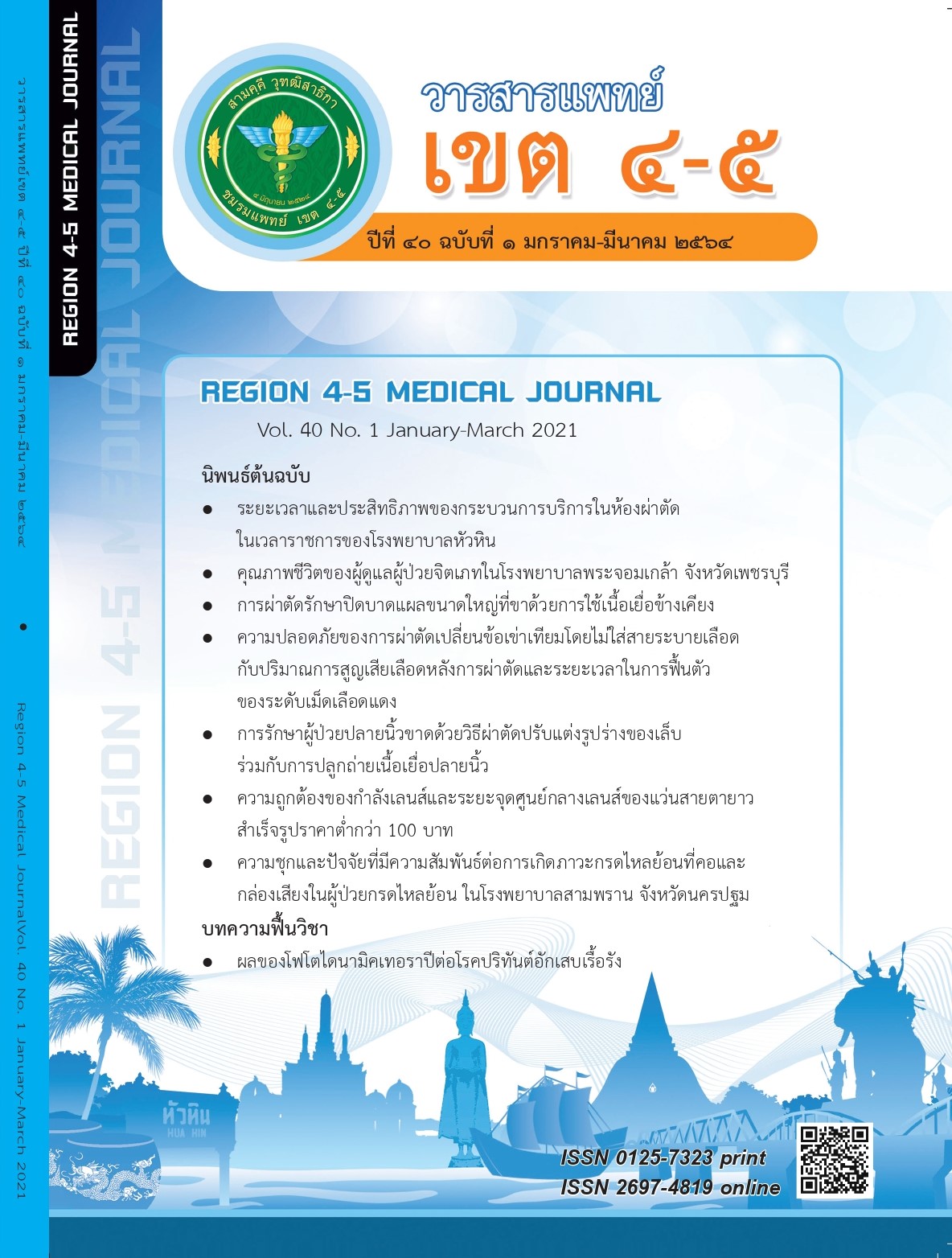ความปลอดภัยของการผ่าตัดเปลี่ยนข้อเข่าเทียมโดยไม่ใส่สายระบายเลือด กับปริมาณการสูญเสียเลือดหลังการผ่าตัดและระยะเวลาในการฟื้นตัวของระดับเม็ดเลือดแดง
คำสำคัญ:
การผ่าตัดเปลี่ยนข้อเข่าเทียม, ปริมาณการสูญเสียเลือด, ระดับฮีโมโกลบิน, ระดับฮีมาโตคริตบทคัดย่อ
วัตถุประสงค์: เพื่อศึกษาว่าการผ่าตัดเปลี่ยนข้อเข่าเทียมโดยไม่ใส่สายระบายเลือดนั้นมีความปลอดภัย และได้ทราบค่าเฉลี่ยของปริมาณการสูญเสียเลือดหลังการผ่าตัดเปลี่ยนข้อเข่าเทียมและระยะเวลาในการฟื้นตัวของระดับเม็ดเลือดแดง
วิธีการศึกษา: การศึกษานี้ทำการเก็บข้อมูลที่โรงพยาบาลสมุทรสาคร ระยะเวลาตั้งแต่เดือนมกราคม 2561 ถึงเดือนมีนาคม 2563 กลุ่มตัวอย่างคือ ผู้ป่วยที่เข้ารับการผ่าตัดเปลี่ยนข้อเข่าเทียมโดยไม่ใส่สายระบายเลือดจำนวน 100 คน (ผ่าตัด 100 เข่า) โดยเก็บข้อมูลความเข้มข้นของเลือด (hemoglobin and hematocrit) ก่อนการผ่าตัด หลังการผ่าตัด 5 วัน 2 สัปดาห์ 1 เดือน 2 เดือน และ 3 เดือน และนำมาคำนวณเลือดที่เสียไปจากการผ่าตัดและดูระยะเวลาที่ความเข้มข้นของเลือดกลับสู่ค่าปกติก่อนการผ่าตัด บันทึกภาวะแทรกซ้อนของแผลหลังการผ่าตัดเปลี่ยนข้อเข่าเทียม
ผลการศึกษา: พบค่าเฉลี่ยปริมาณการสูญเสียเลือด 758.93 มิลลิลิตร ระดับฮีโมโกลบินและระดับฮีมาโตคริตกลับสู่สภาวะปกติที่ระดับก่อนผ่าตัดเฉลี่ย 51.30 วัน มีผู้ป่วยที่ต้องได้รับเลือด 1 ราย และไม่พบภาวะแทรกซ้อนของแผลหลังการผ่าตัด เช่น แผลติดเชื้อ และภาวะเลือดคั่งในข้อเข่า
สรุป: ผลการศึกษาการผ่าตัดเปลี่ยนข้อเข่าเทียมโดยไม่ใส่สายระบายเลือดมีความปลอดภัย ไม่พบอาการแทรกซ้อนของแผลผ่าตัด ระยะเวลาในการฟื้นตัวของระดับความเข้มข้นเม็ดเลือดแดงสามารถกลับสู่สภาวะปกติเท่ากับก่อนทำการผ่าตัดได้ภายใน 3 เดือน (เฉลี่ย 51.30 วัน)
เอกสารอ้างอิง
2. Alshryda S, Mason J, Sarda P, et al. Topical (intra-articular) tranexamic acid reduces blood loss and transfusion rates following total hip replacement: a randomized controlled trial (TRANX-H). J Bone Joint Surg Am. 2013; 95(21): 1969-74. doi: 10.2106/JBJS.L.00908.
3. Friedman R, Homering M, Holberg G, et al. Allogeneic blood transfusions and postoperative infections after total hip or knee arthroplasty. J Bone Joint Surg Am. 2014; 96(4): 272-8. doi: 10.2106/JBJS.L.01268.
4. Silliman CC, Fung YL, Ball JB, et al. Transfusion-related acute lung injury (TRALI): current concepts and misconceptions. Blood Rev. 2009; 23(6): 245-55.doi: 10.1016/j.blre.2009.07.005.
5. Martin A, Prenn M, Spiegel T, et al. Relevance of wound drainage in total knee arthroplasty--a prospective comparative study. Z Orthop Ihre Grenzgeb. 2004; 142(1): 46-50. doi: 10.1055/s-2004-817656.
6. Kim YH, Cho SH, Kim RS. Drainage versus nondrainage in simultaneous bilateral total knee arthroplasties. Clin Orthop Relat Res. 1998; (347): 188-93.
7. Berman AT, Fabiano D, Bosacco SJ, et al. Comparison between intermittent (spring-loaded) and continuous closed suction drainage of orthopedic wounds: a controlled clinical trial. Orthopedics. 1990; 13(3): 309-14.
8. Jones AP, Harrison M, Hui A. Comparison of autologous transfusion drains versus no drain in total knee arthroplasty. Acta Orthop Belg. 2007; 73(3): 377-85.
9. Parker MJ, Roberts CP, Hay D. Closed suction drainage for hip and knee arthroplasty. A meta-analysis. J Bone Joint Surg Am. 2004; 86(6): 1146-52. doi: 10.2106/00004623-200406000-00005.
10. Cao L, Ablimit N, Mamtimin A, et al. Comparison of no drain or with a drain after unilateral total knee arthroplasty: a prospective randomized controlled trial. Zhonghua Wai Ke Za Zhi. 2009; 47(18): 1390-3.
11. Munoz M, bLeal-Noval SR, Restrictive transfusion triggers in major orthopaedic surgery: effective and safe?. Blood transfusion.2013; 11(2): 169.
12. So-Osman C, Nelissen R, Brand R, et al. The impact of a restrictive transfusion trigger on post-operative complication rate and well-being following elective orthopaedic surgery: a post-hoc analysis of a randomized study. Blood Transfusion. 2013; 11(2): 289.
13. Lacher DA, Barletta J, Hughes JP. Biological variation of hematology tests based on the 1999-2002 national health and nutrition examination survey. Natl Health Stat Report. 2012: 12(54): 1-10.
14. Gross JB. Estimating allowable blood loss: corrected for dilution. Anaesthesiology 1983; 58(3): 277-80. doi: : 10.1097/00000542-198303000-00016
15. Evans S, O’Loughlin E, Bruce J. Retrospective audit of blood transfusion and comparison with haemoglobin concentration in patients undergoing elective primary and revisionlower limb arthroplasty. Anaesth Intensive Care. 2011; 39: 480-5.
16. Erskine JG, Fraser C, Simpson R, et al. Blood loss with knee joint replacement. J R Coll Surg Edinb.1981; 26(5): 295-7.
17. Sehat KR, Evans RL, Newman JH. Hidden blood loss following hip and knee arthroplasty. Correct management of blood loss should take hidden loss into account. J Bone Joint Surg Br. 2004; 86: 561-5.
18. Gibon E, Courpied JP, Hamadouche M. Total joint replacement and blood loss: what is the best equation?. Int Orthop. 2013; 37(4): 735-9
19. Stucinskas J, Tarasevicius S, Cebatorius A, et al. Conventional drainage versus four hour clamping drainage after total knee arthroplasty in severe osteoarthritis: a prospective, randomised trial. Int Orthop. 2009; 33(5): 1275–8. doi: 10.1007/s00264-008-0662-4
20. Chotanaphuti T, Wangwittayakul V, Khuangsirikul S. The accuracy of component alignment in custom cutting blocks compared with conventional total knee arthroplasty instrumentation: prospective control trial. The Knee. 2014;21(1):185-8
21. Billett HH. Hemoglobin and Hematocrit. In: Walker HK, Hall WD, Hurst JW, editors. Clinical methods: The history, physical, and laboratory examinations. 3rd ed. Boston: Butterworths; 1990: 151..
22. Quinn M, Bowe A, Galvin R, et al. The use of postoperative suction drainage in total knee arthroplasty: a systematic review. IntOrthop.2015; 39(4): 653-8. doi: 10.1007/s00264-014-2455-2.
ดาวน์โหลด
เผยแพร่แล้ว
รูปแบบการอ้างอิง
ฉบับ
ประเภทบทความ
สัญญาอนุญาต
ลิขสิทธิ์บทความเป็นของผู้เขียนบทความ แต่หากผลงานของท่านได้รับการพิจารณาตีพิมพ์ลงวารสารแพทย์เขต 4-5 จะคงไว้ซึ่งสิทธิ์ในการตีพิมพ์ครั้งแรกด้วยเหตุที่บทความจะปรากฎในวารสารที่เข้าถึงได้ จึงอนุญาตให้นำบทความในวารสารไปใช้ประโยชน์ได้ในเชิงวิชาการโดยจำเป็นต้องมีการอ้างอิงถึงชื่อวารสารอย่างถูกต้อง แต่ไม่อนุญาตให้นำไปใช้ในเชิงพาณิชย์




